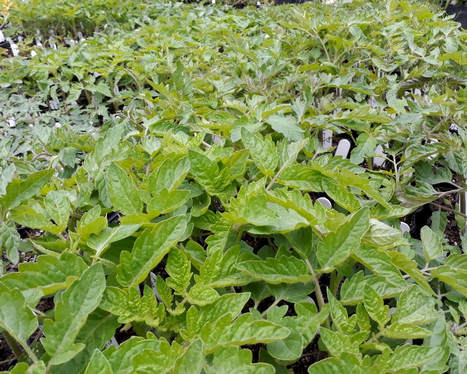|
Earlier this month the plant study group that I am a member of held their monthly meeting, and the study topic was tomatoes. As usual it was a great meeting with so much interesting information brought along for discussion. Everyone agreed that my Mum (Pauline Bassett) should provide a copy of her tomato growing notes so that they could all try her methods and see how they got on this year. Mum has been growing tomatoes in her garden for as long as I can remember (and I obviously caught the bug from her, as I have been growing them in my garden(s) for more than 20 years). Heirloom varieties became popular with us fairly early on as we love the different sizes, shapes, flavours and textures that they bring to the table. Being able to pick a rainbow of tomato fruit each summer for a multitude of uses in the kitchen is a real joy (excluding those that never make it inside because they are like lollies in the garden of course!).
Lots of different methods for soil preparation and plant treatment have been tried over the years, with varying rates of success, but I'm pretty sure Mum has it down to a fine art now and produces a healthy crop every year. With her permission I have included her growing notes below, so that others may benefit from her knowledge. Every gardener is different of course....and I have made my own adjustments to her methods. Yesterday I finally found time to get the bulk of my tomato plants in....in addition to the 3 that I planted a week ago, I planted another 21 different varieties yesterday. Still have another 6 to plant, which will give me 30 tomato plants – I must be bonkers. Anyway, my plants get something similar to Mum’s concoction.....1/2 cup of Anlamb milk powder (when in need...use what’s available), a handful of blood and bone, and each plant surrounded by a mulch of wilted comfrey leaves, slightly buried under the soil, to provide extra minerals. (Comfrey is high in potassium, which tomatoes really need). Compost and lime was applied to the soil last week. Now that it's rained and the soil is damp each plant will also be fed with soil microbes (beneficial soil bacteria and fungi) and liquid seaweed fertilizer mixed with water. My soil has been damaged over the past 6 months due to the extreme wet and replacing these microbes makes sense to me, as it should help to restore the microbial balance needed to fight plant diseases and pests. Anyway, here are Mum's notes..... Pauline’s Tomato Notes October 2017 The plants need good soil. Put stakes in first, on a straight string line. I use bamboo (length 180cm), solid stakes, bang them in with a waratah standard rammer. I grow mostly indeterminate plants, 70cm apart in the rows, 80cm between the rows. This year there will be three rows of four plants, plus Scorsby Dwarf and Yellow Canary on the edge of the garden – they can hang out there! Each planting hole is prepared using a trowel with the hole close to the stake, preferably on the northern side of the stake (the most sun). The magic mix for each planting hole is: ½ cup whole milk powder (calcium, combats blossom end rot) Handful blood & bone (the plants need an early boost of nitrogen) Tablespoon Epsom Salts (anti fungal) Neem granules or kawakawa leaves (to give pests a fright) All of the above seems to work but it could be just muck’n’magic! However I have had better results with this mix in comparison to commercially prepared tomato plant food. I stir the magic mix around in the hole and then plant into it, ensuring that the lower hairy stem up to the first leaves is buried. In other words, normal planting rules are broken – the plant is put in at a greater depth than when it was in its pot. Roots will form along that hairy portion of the stem thus giving greater stability and ensuring better uptake of nutrients. Some years I have made evil concoctions from comfrey leaves steeped in water for foliar feed, but usually I use liquid fish fert about once a fortnight when the tomatoes start to set. I stop the fish fert once they start to ripen, nothing worse than a fishy tomato in a salad! I do mulch with piles of seaweed close to the plants and when I can get it, I use ‘sea mulch’ (mix of leaf-mould and fine red seaweed) between the rows. My plants are kept to a single leader where possible and I take the laterals off religiously. In conjunction with this I keep the plants tied as they grow upwards, using stretchy plant tie material, figure of eight so there is material between the plant stem and the stake, but tied not too tight. Well in theory I do this, but I have been caught out. Ignore them for a few days and they go mad. Sometimes a plant will grow two leaders and by the end of the season I can have some interesting jungle gyms of tomatoes. However I work on the premise of keeping the plants and tomatoes off the ground, tied so they cannot break, but with good air flow around them. Mostly this works! Good luck all tomato growers.
5 Comments
|
Kate JuryOwner-operator of Seaflowers Nursery and serious plant addict! Archives
October 2022
Categories |

 RSS Feed
RSS Feed